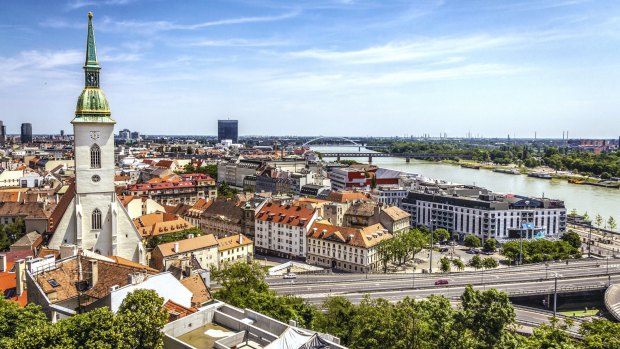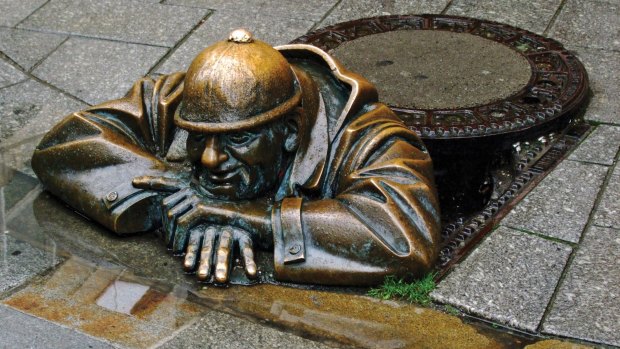This was published 4 years ago
Slovakia: The new European hotspot with a dark past
By Sue Williams

Bratislava skyline.Credit: iStock
There's a grand, white rococo building in the centre of Slovakia's capital, Bratislava, with a contemporary symbolism as potent as its history is long. The late baroque Grassalkovich Palace was built in 1760 for a Croatian noble who lent it regularly to Empress Maria Theresa, the only female ruler ever of the powerful Habsburg empire. Dubbed the White House, these days it's used mostly for official functions, but now featuring another revered female leader.
That's 45-year-old Zuzana Caputova, an environmental campaigner and lawyer without any experience of public office at all, who recently became the first female president of this tiny central European nation. Her barnstorming victory at the election last June is being seen by many as a sign of hope for an end to decades of corruption and repression.
"She's our very own Erin Brockovich," says Slovak guide Michal, of the woman who first came to attention when she managed to close a toxic landfill in her hometown after an epic 14-year legal battle. "It was so refreshing when journalists asked her questions and she seemed to answer with the kind of honesty we've not seen before on the political stage in Slovakia."

Offbeat bronze statue of a sewer worker resting at the top of a manhole, "peeping" at passersby.
Over recent years, Slovakia – formerly part of Czechoslovakia – has become known for its cheap beer and sausages to fuel the excesses of young foreign men and women on international bucks and hen nights. But this small country has now, quite rightly, become a hotspot for much less hedonistic tourism.
For one thing, it's a poster child for economic prosperity among the nations of the former Soviet-led Eastern bloc, with a high standard of living, free market, free education system and excellent social welfare, all supported by its position as, per capita, the world's largest car producer.
For another, it has far more to see than you'd imagine for a mostly mountainous country with a population of only 5.4 million. And now, with a fresh new face as president, there's an air of optimism that makes being a tourist here even more enjoyable.
Caputova's ascension on a platform of fighting corruption, and her social liberalism, are a timely antidote to the authoritarian tilt of many of the continent's governments, most notably next-door neighbours Hungary and Poland. It's just the latest turn in the fortunes of a country that's had more than its fair share of tumult. And everywhere you look in Bratislava, that colourful history comes alive.
Today, at the palace, with its extensive palace gardens - open to the public – and pretty fountain out front symbolising freedom, there's a frenzy of politicking between the new president and the ruling party. Its prime minister and entire cabinet were forced to resign last year (2018) after mass protests following the murder of a well-known journalist who'd been working on a story about political corruption.
Here, at this very square, the former speaker of the Parliament gave a speech comparing those latest protests to the 1989 "Velvet Revolution" that ended communist rule. "The revolution started by the parents," declared František Mikloško, "has to be finished by their children."
But, of course, Bratislava's turbulent history stretches much further back than the fall of Communism.
The Danube on which the city sits, for instance, has never been blue, more a greeny-brown. But it was possibly given it honorific hue because of the blue uniforms of Napoleon's army, after many French soldiers drowned in the water following their unsuccessful one-month siege of Bratislava in 1809 – the Little Emperor's first defeat.
On their retreat, however, they did turn the medieval Devin Castle, standing on the outskirts of the city high on a cliff, into ruins. It's an eerie place now but the panoramic views over the Danube remain as spectacular as ever.
The first bridge over the Danube mirrors the city's turbulent history, too. Originally built in 1825 and christened Starý most or "old bridge", it was rebuilt in 1891 as Franz Joseph Bridge, after the longest-reigning Emperor of Austria and King of Hungary.
During the first Czechoslovak republic, it became Štefánik Bridge, in honour of a Slovak politician, then, in World War II, under Nazi occupation, Adolf Hitler Bridge, before most of its steel structure was destroyed. When the Russians arrived in 1945, it was rebuilt on its old stone pillars and renamed Red Army Bridge. Today, it's back to Old Bridge.
The Old Town has been beautifully preserved, however, throughout times of great upheaval. With cobbled, car-free streets, it's a gorgeous place to wander through, with museums, art galleries, both formal and quirky statues, and glorious buildings on almost every corner.
The stone town hall has survived from the 14th Century, for example, with its tower dating from 1370. There's the medieval St Michael's Gate and tower with its statue of George and the dragon. Then there's the stately St Martin's Cathedral, built into the city's fortressed walls in 1452, with its 85-metre spire that can be seen from everywhere, next to a still-functioning seminary.
The cathedral hosted the coronations of Hungarian royalty until 1830, and on top of the tower there's a sculpture of the Hungarian crown on a gilded pillow. In total, 11 kings and queens were crowned here, including Maria Theresa who walked in the procession in a dress that was estimated to have weighed 40kg.
The coronations were immensely popular among the locals – they were treated to a huge feast and tossed freshly-minted coins – and gold crowns are still set into the paving stones to mark the procession route. Every year that coronation ceremony is re-enacted in late June.
Nearby, there's a bust of Hungarian composer and pianist Franz Liszt. He first visited Bratislava to play in a concert at the age of nine, and impressed the locals so much, a group of wealthy businessmen contributed towards a scholarship for his music studies.
"But he was an amazing man," says Michal. "He was the first rock star in the world. All his concerts were packed out and at every concert he wrecked a piano and ripped apart the cushion he sat on because everyone wanted a piece.
"He'd even throw his gloves into his adoring audience as a souvenir."
The city had much to endure with invasions by Napoleon, Germany, the USSR, and then the Russians again, to crush the growing liberalism of the Prague Spring.
Šafárikovo Square was front and centre during the invasion of Czechoslovakia in August 1968 by Soviet-led Warsaw Pact forces after Slovak-born prime minister Alexander Dubček introduced reforms in defiance of Moscow.
A photograph of Emil Gallo, a Slovak plumber, standing bare-chested in front of a Warsaw Pact tank was once as famous as the 1989 photo of the Chinese protestor who stood in front of the tank in Beijing's Tiananmen Square.
But Bratislava is captivated by the promise of a bright future while trading on its colourful and cultured past.
The ancient cobbled streets are lined with beautiful turn-of-the-20th Century apartment buildings, outdoor cafes, pubs, bars – sparkling wine from Slovakia was, apparently, served on the Titanic -- shops and handicraft markets. Towering over them is the Gothic turreted Bratislava Castle, dating back to the 15th Century.
And now, with Caputova installed as president, it seems the dark days of a troubled history are firmly in the past. "I offer my mind, my heart and my hands," she said at her swearing-in ceremony.
"She is so cool," says our guide Michal. "She'll be great for our country."
FIVE DISHES NOT TO MISS IN SLOVAKIA
BRYNDZOVÉ HALUŠKY
Potato dumplings with sheep cheese and scattered with roasted bacon bits
KAPUSTNICA
The national dish of soup made from sauerkraut, potatoes, onions, dried mushrooms, sausage and other meats.
ZEMIAKOVÉ PLACKY
Pancakes made with potato and often, as balkanska pochúťka, stuffed with stewed pork, onions, peppers and tomatoes, with cheese sprinkled on top.
VYCHODNIARSKY REZEN
A chicken schnitzel made from chicken breast and served with green beans, ham, cheese and potato wedges.
ŽEMĽOVKA
A sweet pudding made from apples, eggs and white bread soaked in warm milk and sugar.
TRIP NOTES
FLY
Qantas, Qatar Airways and Emirates all fly to Budapest with only one stop, in either Dubai or Doha.
CRUISE
The APT-Traveller 15-day Budapest-to-Budapest small group "Voyage Through the Balkans" cruise is inclusive of sight-seeing, guides, cruise director, meals and most drinks on board, tipping, Wi-Fi, port charges and transfers. From $8995 per person twin-share. Phone 1300 336 932; see aptouring.com.au
MORE
Sue Williams was a guest of APT.
Sign up for the Traveller Deals newsletter
Get exclusive travel deals delivered straight to your inbox. Sign up now.